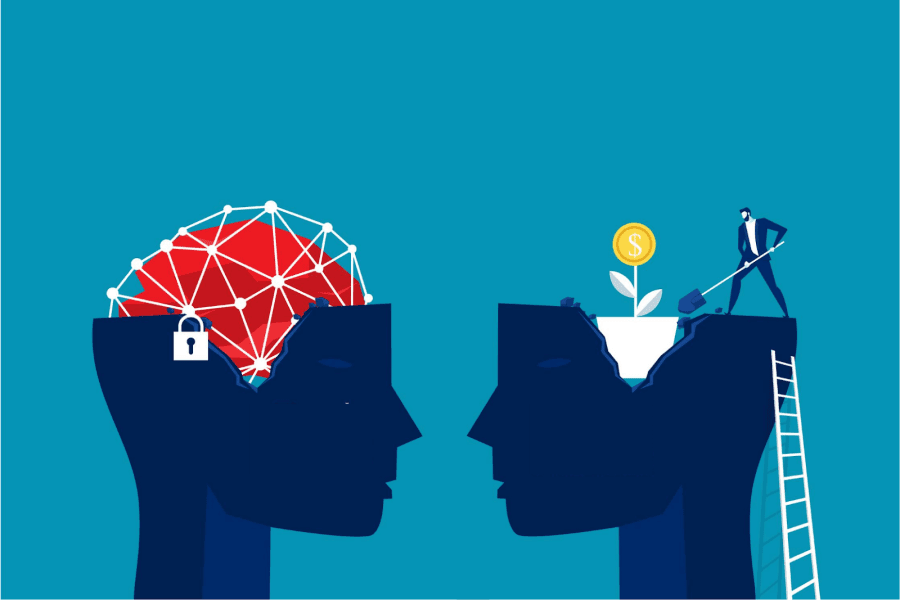
Why Do We Need Organizational Growth Mindset?
“When you enter the world of the growth-mindset leaders, everything changes. It brightens, it expands, it fills with energy, with possibility.” Carol Dweck

Considering the vast nature of Growth Mindset, from its theoretical framework and intervention architecture, to its link to organizational change management and change fatigue, we believe it’s better to delve into the specifics through a series of blog posts, of which this is volume 1.
Growth Mindset and Fixed Mindset
Why are some people devastated by failures and setbacks whereas others find ways to learn from failures and rebound? Stanford professor Carol Dweck answered this question by introducing the terms growth mindset and fixed mindset. Dweck has held the position of Professor of Psychology at Stanford University since 2004, teaching developmental psychology, self theories, and independent studies.
Growth mindset is the understanding that abilities are flexible and can be developed through effort and resilience. The fixed mindset, on the other hand, is the belief that abilities are innate and cannot be changed. Growth mindset has been applied to corporate environments and has been found to increase overall productivity and performance. Intuitively this seems to make total sense. In this article, we will present you with the biggest science-based benefits of implementing it in your organization.
Neuroplasticity
Neuroscience research has found that our brain plasticity is malleable and that we can build, grow, and strengthen our neuronal networks (a.k.a. neuroplasticity). Our brain is able to physically change and adapt! For example, a study on performance-monitoring and adaptive behavioral adjustment using event-related potentials such as electrical brain signals found differences between individuals with a growth mindset and individuals with a fixed mindset.
Specifically, increased and conscious attention to mistakes was observed in individuals with a growth mindset, leading to improved performance (Moser et al., 2011). In other words, this means that our experiences, memories, and learnings can change the physical structure of our brain. Given the results from this study, it is important for leaders and managers to consider the mindset that companies endorse in order to maximize productivity and performance.
Increased Workers Satisfaction
Growth Mindset (GM) has been found to increase workers’ satisfaction. Employees with a growth mindset show less fear of failure and take more initiative. Supervisors in GM companies report more positive views about their employees and overall rate them as more innovative, collaborative, and committed to learning and growing. Overall, growth mindset companies have happier employees compared to companies with fixed mindset employees.
Increased Commitment
Cultures of productive and economically successful organizations are often characterized by the norms of collaboration, innovation, and integrity/ethical behavior. They characterize successful organizational cultures, in part, by fostering greater trust and commitment among employees. Companies that endorse a growth mindset emphasize that skills and abilities can be developed further through commitment. Employees in growth mindset companies were 34% more likely to feel a strong sense of ownership and commitment to the company they work for. Committed employees take ownership of their work and are more motivated than less committed employees.
Increased Trust
The mindset that an organization endorses shapes the expectations of and interactions between employees. A culture of open and honest communication helps build a trustworthy and collaborative workplace. Organizational trust is defined as the employee’s belief that the organization acts with integrity. Employees in companies that stimulate a growth mindset saw a 47% higher agreement with statements about having more trust in their company. Meanwhile, employees in companies that endorse a fixed mindset reported less organizational trust as well as a stronger desire to leave the company for other opportunities (Canning et al., 2019). Organizational trust has also been linked to increased job satisfaction and productivity.

Increased Risk-Taking Culture
When a company is focused on numerical successes, it hinders opportunities for risk-taking and genuine improvements. As part of fostering a growth mindset culture, companies have been incorporating looking-forward reviews as opposed to looking-back reviews. How does this look in practice? They have been asking employees “What will you learn?” during frequent feedback session to drive a process of self-development. This approach has helped to empower employees and at the same time has encouraged ownership of projects. As such, employees working for a company that encourages a growth mindset are 65% more likely to report that the company supports risk-taking.
Increased Innovation Culture
Norms of innovation encourage novel ideas and approaches which help develop new products or services. Employees that exhibit a fixed mindset usually follow the same routines leading to the same outcomes. However, in companies that value a growth mindset employees are empowered to innovate and progress. 49% of employees in GM companies report that the company fosters innovation.
Growth Mindset in Hiring
Growth mindset in hiring decisions has shifted the focus on hiring individuals who will become talented over time rather than individuals with a fixed talent.
Fostering and endorsing a growth mindset starts as early as recruitment stages. Imagine that a company bases their hiring decisions mainly on the candidates’ fixed talent. This exact situation was used by Carol Dweck to emphasize the importance of growth mindset in hiring decisions. Enron, an American energy company, emphasized hiring highly talented individuals which slowly created a fixed mindset culture where employees preferred to lie than admit to being wrong. Instead, Carol Dweck suggests following the lead of leaders like Jack Welch (despite his infamous 10% rule) by rewarding teamwork and progress rather than individual genius (Dweck, 2007).
Building a team of people with a similar (growth) mindset showed that employees were more willing to share ideas and opinions openly compared to teams with a fixed mindset.
During the recruitment process, asking questions such as “What would make you successful in a role that is outside of your current abilities?” helps identify candidates with a growth mindset. For example, Carol Dweck studied the mindset of members of a baseball team by asking them what they would change to become successful at the top level. She was specifically looking for an answer that acknowledged the need to put in an effort to improve their skills.
Now that we’ve outlined the benefits of a growth mindset, here are some real-life applications of growth mindset interventions:
- Cigna, an American healthcare and insurance company, replaced its traditional “reward for performance” system with a “reward for contribution” system. With this shift, they started focusing on future results rather than past performances and promoting a culture of feedback. As a result, 94% of their managers reported improved leadership skills and employee motivation and engagement rose (NeuroLeadership Institute, 2022).
- Salt River Project, an American public utility company, implemented a shift in mindset in their company by gradually introducing their employees to the power of growth mindset. Specifically, they focused on teaching them to embrace this mindset, always improve, and inspire others. As a result, the employees reported feeling very or extremely prepared to always improve and the Salt River Project team reported increased risk-taking and innovation in the company (NeuroLeadership Institute, 2022b).
Quick Recap:
- The mindset endorsed by a company affects productivity and performance of the company as well as the brain plasticity of its employees.
- A growth mindset focuses on the learning curve and process and leads to increased workers satisfaction, commitment, trust, risk-taking, and innovation.
Interested in Growth Mindset? Stay tuned for our next article on tactical implementations you can introduce to cultivate a growth mindset!
We hope this article was useful to you and if you’re looking for a behavioral business partner who can drive change in your organization, we’d love to schedule a call or coffee. If you want to learn more about behavioral insights, read our blog or watch 100+ videos on our YouTube channel!
About Neurofied
Neurofied is a behavioral science company specialized in training, consulting, and change management. We help organizations drive evidence-based and human-centric change with insights and interventions from behavioral psychology and neuroscience. Consider us your behavioral business partner who helps you build behavioral change capabilities internally.
Since 2018, we have trained thousands of professionals and worked with over 100 management, HR, growth, and innovation teams of organizations such as Johnson & Johnson, KPMG, Deloitte, Novo Nordisk, ABN AMRO, and the Dutch government. We are also frequent speakers at universities and conferences.
Our mission is to democratize the value of behavioral science for teams and organizations. If you see any opportunities to collaborate, please contact us here.
